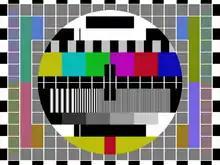Hanover bars
Hanover bars, in one of the PAL television video formats, are an undesirable visual artifact in the reception of a television image. The name Hanover refers to the city (Hannover) in which the PAL system developer Telefunken Fernseh und Rundfunk GmbH was located.

Two signals, B-Y (U) and R-Y (V) are used in the PAL system to carry the color information for a picture, with the phase of the V signal (hue) reversed (i.e. shifted through 180 degrees) on alternate lines (hence the name PAL, or phase alternate line). This is done to cancel minor phase errors in the reception process. However, if gross errors occur, complementary errors from the V signal carry into the U signal, and thus visible stripes occur.
Later PAL systems introduced alterations to ensure that Hanover bars do not occur, introducing a "swinging burst" to the color synchronization. Other PAL systems may handle this problem differently.
Suppression of Hanover bars

To suppress Hanover bars, PAL color decoders use a delay line which repeats the chroma information from each previous line, and blends it with the current line.[1] This causes phase errors to cancel out, at the cost of vertical color resolution, and in early designs, also a loss of color saturation proportional to the phase error.
References
- "Worldwide Standards for Analog Television". National Association of Broadcasters Engineering Handbook. Academic Press. 2007.